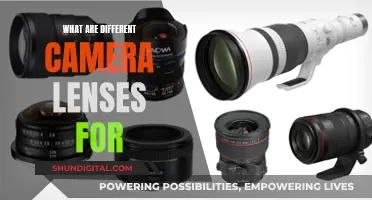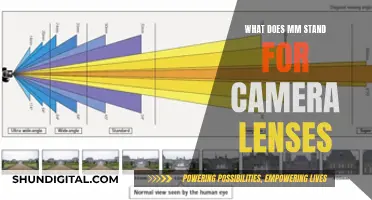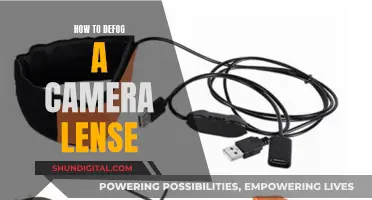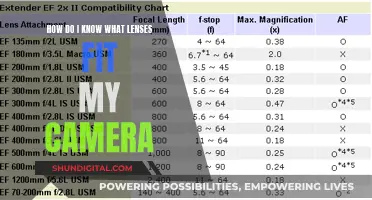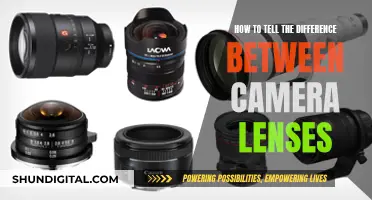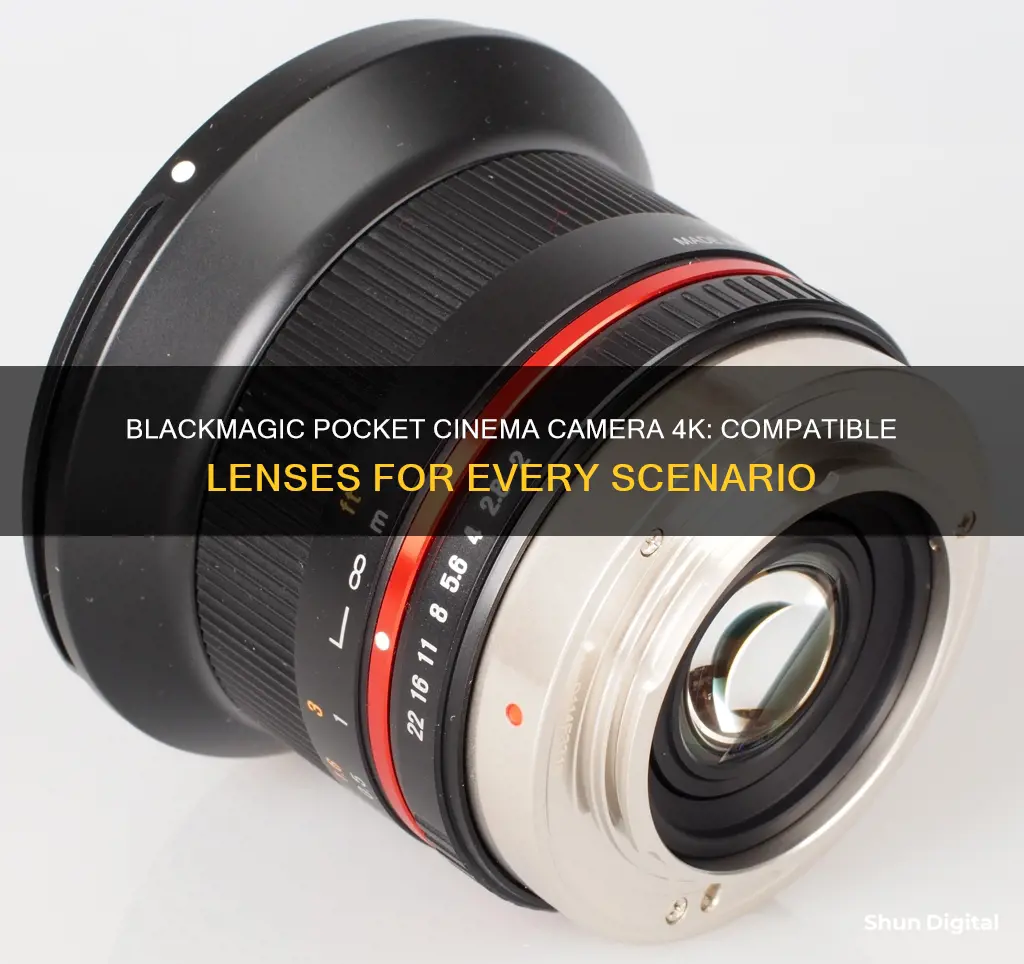
The Blackmagic Pocket Cinema Camera 4K is compatible with a wide range of lenses. The camera has a Micro Four Thirds (MFT) lens mount, which means that any MFT-mount lenses made by Panasonic, Olympus, and third-party brands like Sigma, Voigtländer, Tokina, Rokinon, MEKE, Meike, SLR, and DZOFilm are compatible.
Other lenses can also be used with the camera by using an adapter. Canon EF, Nikon F, and PL lenses are commonly adapted to the BMPCC 4K, and some adapters, like the Metabones Speed Booster and Viltrox EF-M2, allow the camera and lens to maintain electronic communication, enabling the use of autofocus and aperture control.
In addition to these options, cinema lenses from manufacturers like Zeiss, Leica, and Sigma Art, as well as vintage or anamorphic lenses, can also be used with the BMPCC 4K.
| Characteristics | Values |
|---|---|
| Lens compatibility | Fujinon, Meike, Tokina, Vazen, Canon EF, Nikon F, PL, and other lenses |
| Lens compatibility (with adapter) | Canon EF, Nikon F, PL, and other lenses |
| Lens mount | Micro Four Thirds |
| Lens adapter | Metabones Speed Booster, Viltrox EF-M2 |

Micro Four Thirds lenses
The Blackmagic Pocket Cinema Camera 4K has a Micro Four Thirds lens mount, meaning that Micro Four Thirds lenses are compatible with the camera. This includes lenses from manufacturers such as Panasonic, Olympus, Sigma, Voigtländer, Tokina, Rokinon, Meike, and DZOFilm.
- Olympus Zuiko Pro 12-40mm f/2.8: This lens offers a versatile focal range of 12-40mm (24-80mm full-frame equivalent) and a constant aperture of f/2.8, allowing you to maintain consistent exposure levels when zooming. It features high-quality optics that minimise distortion and aberrations, resulting in sharp and clear images with excellent contrast and colour accuracy. The lens is also all-metal and weather-sealed, making it robust and suitable for various shooting conditions.
- DZOFilm DZO 20-70mm T2.9: This is a parfocal cine zoom lens with a versatile focal range, making it ideal for shooting a variety of scenarios. It has a maximum aperture of T2.9, providing great low-light performance and shallow depth of field control. The lens is durable, with an all-metal construction, smooth focus and zoom rings, and industry-standard gear teeth for compatibility with follow focus systems. It delivers outstanding optical quality, with sharp and colour-accurate images.
- SLR Magic MicroPrime CINE 17mm T1.5: This lens gives your footage a cinematic look and feel with its 17mm focal length and super-wide 94.8-degree view. It is compact, lightweight, and durable, making it ideal for handheld shooting. The lens is designed with filmmakers in mind, featuring geared manual focus and aperture rings for precise control. It also has gear teeth for compatibility with follow focus systems. Despite its low price, it delivers premium-quality images with sharp and high-resolution results.
- Meike 8mm T2.9: This super wide-angle lens from Meike offers a focal length of 8mm (16mm full-frame equivalent), making it perfect for capturing expansive landscapes or establishing shots. The maximum aperture of T2.9 provides good low-light performance and depth-of-field control. The lens is durable, compact, and lightweight, with gear teeth for accessory compatibility. It delivers excellent image quality, with sharp and clear images across the frame, handling distortion well for an ultra-wide lens.
Buffing Out Scratches: Restoring Camera Lenses to Perfection
You may want to see also

Canon EF lenses
There are a variety of active adapters available for the BMPCC 4K, including:
- Metabones Speed Booster: This adapter not only allows the use of Canon EF lenses but also increases the maximum aperture by 1 stop and provides a wider field of view.
- Metabones Smart Adapter: A more affordable option from Metabones that does not include the custom-designed optics of the Speed Booster, but still allows for control of the aperture and other features.
- Kipon EF to MFT AF Adapter: Another affordable active adapter option that includes autofocus support.
- Aputure DEC EF to MFT Adapter: This adapter comes with a wireless controller, allowing for remote adjustment of focus and recording.
- Redrock Micro LiveLens: Redrock Micro was one of the first manufacturers to release an active EF to MFT adapter and has been a popular option for several years.
When choosing an adapter, it is important to consider the specific Canon EF lenses being used, as some lenses may have unique characteristics or requirements. Additionally, the desired level of control and functionality, as well as budget, will also influence the adapter selection.
It is worth noting that Canon EF lenses are just one of many lens options for the BMPCC 4K. The camera's native Micro Four Thirds (MFT) lenses can be used without an adapter, and other lens mounts, such as Nikon F, can also be adapted for use with the camera. Ultimately, the best lens and adapter combination will depend on the specific needs and preferences of the user.
Selling Camera Lenses: Tips for a Quick Sale
You may want to see also

Nikon F lenses
The Nikon F camera was introduced in 1959 and was one of the most advanced cameras of its day. It was the first 35mm SLR system to be widely adopted by professional photographers, especially photojournalists. The "F" in Nikon F was selected from the term "re-f-lex", since the pronunciation of the first letter "R" is not available in many Asian languages. The Nikon F was succeeded by the Nikon F2 in 1972, but aspects of its design remain in all of Nikon's subsequent SLR cameras. The camera was the first to use the F-mount bayonet lens mount system, which is still used today.
The Nikon F is compatible with the Blackmagic Pocket Cinema Camera 4K, but you will need an adapter as the camera uses a Micro Four Thirds (MFT) lens mount. The Nikon F has a large bayonet mount, and its F-mount has a large inner diameter, which was designed to ensure compatibility with all available interchangeable lenses. The F-mount has been in use for over 60 years without any changes, so you should be able to find an adapter that will allow you to use your Nikon F lenses with the Blackmagic Pocket Cinema Camera 4K.
When choosing an adapter, it's important to consider the flange focal distance. The Nikon F has a flange focal distance of 44mm, which is larger than the MFT flange focal distance of 19.25mm. This means that you will need an adapter that can make up for the difference in flange focal distance.
It's also important to note that the Nikon F lenses do not have aperture rings, so you will need an adapter with gold contacts that allow you to control the aperture. Additionally, some Nikon F lenses have protruding elements at the back that may not interface correctly with the adapter, so it's important to check for compatibility.
Overall, the Nikon F lenses are a great option for the Blackmagic Pocket Cinema Camera 4K if you already have them or can find them at a good price. They offer a wide range of focal lengths, from 21mm to 1000mm, and are known for their durability and reliability. Just make sure you get the right adapter to ensure a smooth shooting experience.
Radioactive Camera Lenses: Are They Safe to Use?
You may want to see also

PL lenses
The flange focal distance of the MFT system is 19.25mm, so you will need an adapter with a flange focal distance greater than this. Some adapters that meet this requirement include the Metabones Speed Booster and the Viltrox focal reducer.
When choosing an adapter, it is important to consider the following:
- Some lenses have protruding elements at the back that may not interface correctly with the adapter.
- Modern lenses without aperture rings will require an adapter with gold contacts to allow the camera to control the aperture.
- Some adapters allow for autofocus with third-party lenses, but this may not work as well as with native lenses.
- It is important to choose a well-made adapter to avoid issues such as tight fit or play, which can affect the performance of the lens.
- Cheap adapters may not be precisely machined, affecting the flange focal distance accuracy and infinity focus.
- Heavier metal lenses may require an adapter with better mechanics for support.
- Internal reflections and light leaks can occur if the internals of the adapter are not well-made.
- Adapters add bulk to the camera setup.
How Camera Lenses Form Images: Inverted or Upright?
You may want to see also

Speed Boosters
One of the key advantages of using a Speed Booster is the increase in aperture by one stop. For example, with an F2.8 lens, you can boost the aperture to F2.0. This increase in aperture also results in a wider field of view since you can now capture the full image properly.
Additionally, Speed Boosters have an internal chip that enables the camera to control the lens's aperture, stabilization, and focus. This integration ensures seamless communication between the camera and the adapted lens.
When choosing a Speed Booster, it's important to consider the magnification factor. The most common options are the Speed Booster Ultra 0.71x and the Viltrox EF-M2. The Speed Booster Ultra provides a slightly higher magnification factor, resulting in a wider field of view.
It's worth noting that Speed Boosters are not cheap, and they may introduce some image degradation due to the additional optical element between the lens and the sensor. However, the benefits of increased light-gathering ability and wider field of view make Speed Boosters a popular choice for adapting lenses to the Blackmagic Pocket Cinema Camera 4K.
Camera Lenses: Tangible Personal Property or Not?
You may want to see also
Frequently asked questions
The Blackmagic Pocket Cinema Camera 4K has a Micro Four Thirds lens mount. This means that any Micro Four Thirds lens will be compatible with the camera. Some examples of brands that make Micro Four Thirds lenses are Panasonic, Olympus, Sigma, Voigtländer, Tokina, Rokinon, MEKE, Meike, SLR, and DZOFilm.
Yes, you can use non-Micro Four Thirds lenses with the Blackmagic Pocket Cinema Camera 4K, but you will need to use a lens adapter. Some common lens mounts that will require an adapter to work with the camera are Canon EF, Nikon F, and PL.
A Speed Booster/Focal Reducer is an adapter that reduces the effective focal length of a lens while increasing its maximum aperture. This is useful for cameras with small sensors, like the Blackmagic Pocket Cinema Camera 4K, as it can help to mitigate the crop factor and enhance low-light performance and depth of field.


